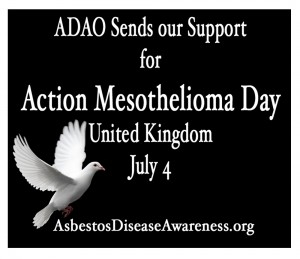 Action Mesothelioma Day
Action Mesothelioma Day
On Friday, July 4, organisations throughout the UK hosted Action Mesothelioma Day events to raise awareness about mesothelioma and remember those who have lost their battle with the disease. At the Asbestos Disease Awareness Organization (ADAO), we are proud supporters of Action Mesothelioma Day. We admire the national scope and unity in the UK in the struggle for a world free from asbestos and I am honored to share my story in this guest blog.
The Health and Safety Executive reported an “increase in cases of mesothelioma of more than 10 per cent, due largely to a greater number of male deaths aged 65 and over.” The Independent wrote, “There were 2,535 mesothelioma deaths in 2012, up from 2,291 in 2011, and, of those, 2,126 were men and 409 were women. “While promising research continues, prevention remains the only cure.
Mes-o-the-li-o-ma – can’t pronounce it – can’t cure it.
I remember it as if it were yesterday; the day my husband Alan was diagnosed with malignant pleural mesothelioma in Los Angeles, CA. We had never heard of mesothelioma. We were devastated when we learned that the asbestos-caused disease has no cure. Our daughter was only 10 years old.
Alan had no idea how he was exposed to asbestos. Back in the 1960s, he had done a short stint as an engineer inside nuclear submarines when they were being built. In those days, asbestos was a common insulation material in gaskets, boiler rooms and many other places inside ships. Alan was good with his hands and loved to do home repairs. He removed contaminated floor tiles and fixed walls with compounds that probably contained asbestos. Like many other asbestos victims who suffer from these terrible diseases, he had many encounters with this substance. That’s part of the tragedy: our inability to identify toxic materials and products. We are left in the dark and cannot always avoid being exposed.
An avid marathon runner, Alan underwent chemotherapy and radical surgeries in hopes of buying more time with his family. He spent his last year tethered to oxygen 24 hours a day, as mesothelioma ravaged his body. He died in 2006, three years after diagnosis, with our then 13-year-old daughter and me by his side.
Fueled by my intense grief and anger about Alan’s mesothelioma diagnosis, I co-founded ADAO an independent nonprofit dedicated to eliminating asbestos-caused diseases through education, advocacy, and community initiatives.
Deadly Hugs and Killer Chores
Trust me. It is not just workers who have paid the ultimate price for their jobs – it is also their families. The National Cancer Institute stated, “This risk is thought to result from exposure to asbestos fibers brought into the home on the shoes, clothing, skin, and hair of workers.”
Occupational Diseases are No Accident
Without adequate regulations, people cannot determine or manage consumer, environmental and occupational asbestos risk.
The annual world production trend is currently steady at 2 million tons. Chrysotile accounts for 95% of the asbestos mined and Russia is responsible for 50% of global production.
According to the World Health Organization: “All types of asbestos cause lung cancer, mesothelioma, cancer of the larynx and ovary, and asbestosis (fibrosis of the lungs).”
Building a Culture of Prevention
Preventing exposure is especially difficult because of asbestos’ extremely small fiber size, public misconception about safe use, and the long latency period from 10 to 50 years for disease to present.
Prevention saves lives and dollars. As the International Social Security Association reported in 2011, the “cost-benefit potential for investments in prevention may be as strong as 1: 2.2, and even higher in some cases.”
While mining continues, the World Health Organization clearly states, “The most efficient way to eliminate asbestos-related diseases is to stop the use of all types of asbestos.”
Standing at the Intersection Where Knowledge and Action Unite
Through collaborative efforts and leveraging social media advocacy, we are strengthening engagement with civil society, unions, non-governmental organizations, private sector, and governments.
The digital revolution is exciting and promising for all of us. The advancement of technology has lowered the cost barrier for mobile devices and tablets, paving the wave for efficient, effective, and rapid global and national communication to raise awareness, promote education, increase compliance, and expand transparency and enforcement. More than 90% of the global population lives in locations with access to mobile digital devices, making it possible for the US and UK to join together in the global alliance we truly need to stop this manmade disaster. Together, change is possible.
Guest post by Linda Reinstein

A chartered (fellow) safety and risk management practitioner with 20+ years of experience. David provides a healthy dose of how-to articles, advice and guidance to make compliance easier for construction professionals, Architects and the built environment. Get social with David on Twitter and Linkedin.



